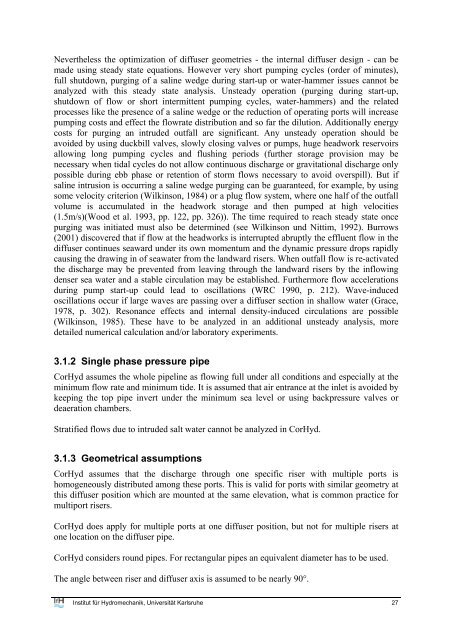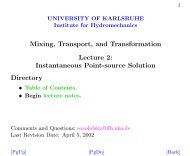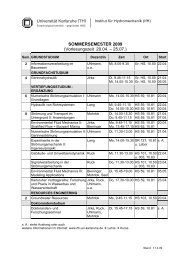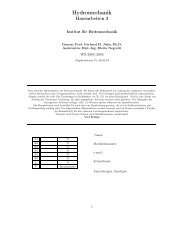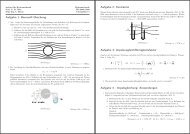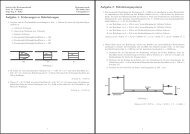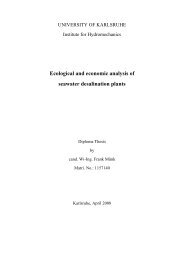user's manual for corhyd: an internal diffuser hydraulics model - IfH
user's manual for corhyd: an internal diffuser hydraulics model - IfH
user's manual for corhyd: an internal diffuser hydraulics model - IfH
You also want an ePaper? Increase the reach of your titles
YUMPU automatically turns print PDFs into web optimized ePapers that Google loves.
Nevertheless the optimization of <strong>diffuser</strong> geometries - the <strong>internal</strong> <strong>diffuser</strong> design - c<strong>an</strong> be<br />
made using steady state equations. However very short pumping cycles (order of minutes),<br />
full shutdown, purging of a saline wedge during start-up or water-hammer issues c<strong>an</strong>not be<br />
<strong>an</strong>alyzed with this steady state <strong>an</strong>alysis. Unsteady operation (purging during start-up,<br />
shutdown of flow or short intermittent pumping cycles, water-hammers) <strong>an</strong>d the related<br />
processes like the presence of a saline wedge or the reduction of operating ports will increase<br />
pumping costs <strong>an</strong>d effect the flowrate distribution <strong>an</strong>d so far the dilution. Additionally energy<br />
costs <strong>for</strong> purging <strong>an</strong> intruded outfall are signific<strong>an</strong>t. Any unsteady operation should be<br />
avoided by using duckbill valves, slowly closing valves or pumps, huge headwork reservoirs<br />
allowing long pumping cycles <strong>an</strong>d flushing periods (further storage provision may be<br />
necessary when tidal cycles do not allow continuous discharge or gravitational discharge only<br />
possible during ebb phase or retention of storm flows necessary to avoid overspill). But if<br />
saline intrusion is occurring a saline wedge purging c<strong>an</strong> be guar<strong>an</strong>teed, <strong>for</strong> example, by using<br />
some velocity criterion (Wilkinson, 1984) or a plug flow system, where one half of the outfall<br />
volume is accumulated in the headwork storage <strong>an</strong>d then pumped at high velocities<br />
(1.5m/s)(Wood et al. 1993, pp. 122, pp. 326)). The time required to reach steady state once<br />
purging was initiated must also be determined (see Wilkinson und Nittim, 1992). Burrows<br />
(2001) discovered that if flow at the headworks is interrupted abruptly the effluent flow in the<br />
<strong>diffuser</strong> continues seaward under its own momentum <strong>an</strong>d the dynamic pressure drops rapidly<br />
causing the drawing in of seawater from the l<strong>an</strong>dward risers. When outfall flow is re-activated<br />
the discharge may be prevented from leaving through the l<strong>an</strong>dward risers by the inflowing<br />
denser sea water <strong>an</strong>d a stable circulation may be established. Furthermore flow accelerations<br />
during pump start-up could lead to oscillations (WRC 1990, p. 212). Wave-induced<br />
oscillations occur if large waves are passing over a <strong>diffuser</strong> section in shallow water (Grace,<br />
1978, p. 302). Reson<strong>an</strong>ce effects <strong>an</strong>d <strong>internal</strong> density-induced circulations are possible<br />
(Wilkinson, 1985). These have to be <strong>an</strong>alyzed in <strong>an</strong> additional unsteady <strong>an</strong>alysis, more<br />
detailed numerical calculation <strong>an</strong>d/or laboratory experiments.<br />
3.1.2 Single phase pressure pipe<br />
CorHyd assumes the whole pipeline as flowing full under all conditions <strong>an</strong>d especially at the<br />
minimum flow rate <strong>an</strong>d minimum tide. It is assumed that air entr<strong>an</strong>ce at the inlet is avoided by<br />
keeping the top pipe invert under the minimum sea level or using backpressure valves or<br />
deaeration chambers.<br />
Stratified flows due to intruded salt water c<strong>an</strong>not be <strong>an</strong>alyzed in CorHyd.<br />
3.1.3 Geometrical assumptions<br />
CorHyd assumes that the discharge through one specific riser with multiple ports is<br />
homogeneously distributed among these ports. This is valid <strong>for</strong> ports with similar geometry at<br />
this <strong>diffuser</strong> position which are mounted at the same elevation, what is common practice <strong>for</strong><br />
multiport risers.<br />
CorHyd does apply <strong>for</strong> multiple ports at one <strong>diffuser</strong> position, but not <strong>for</strong> multiple risers at<br />
one location on the <strong>diffuser</strong> pipe.<br />
CorHyd considers round pipes. For rect<strong>an</strong>gular pipes <strong>an</strong> equivalent diameter has to be used.<br />
The <strong>an</strong>gle between riser <strong>an</strong>d <strong>diffuser</strong> axis is assumed to be nearly 90°.<br />
Institut für Hydromech<strong>an</strong>ik, Universität Karlsruhe 27


